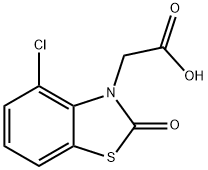Uses
Benazolin is a selective systemic herbicide developed
in the 1960s that has growth-regulatory action in
susceptible plants. Structurally, it is a benzothiazolacetic
acid and is unrelated to the four major groups of synthetic
auxins discussed thus far. Benazolin controls a range of
annual broadleaf weeds in alfalfa (Medicago sativa), canola
(Brassica spp.), cereals, clover (Trifolium spp.), corn (Zea
mays), grassland, and flax (Linum usitatissimum), and it
has a relatively low persistence in the environment.
Definition
ChEBI: A member of the class of benzothiazoles that is 4-chloro-1,3-benzothiazol-2(3H)-one which is substituted on the nitrogen by a carboxymethyl group and at position 4 by chlorine. A post-emergence herbicide used (generally as a salt or este
) for the control of annual weeds in wheat and oilseed rape. It is not approved for use with the European Union.
Safety Profile
Moderately toxic by ingestion. Anherbicide. When heated to decomposition it emits toxicfumes of SOx, Cl
-, and NOx.
Metabolism
Because benazolin is not degraded
by light and is not readily volatilized, the most important
factors affecting its persistence in the environment are
microbial breakdown and leaching. However, because
the microbial breakdown is so rapid, significant leaching
may not occur unless the rainfall within a few days of
application is large.
Toxicity evaluation
Benazolin is primarily excreted in
the urine as N-[2-chloro-6-(methylsulfinyl)phenyl]glycine
and N-[N-[2-chloro-6-(methylthio)phenyl]glycinyl]aniline.
Acid-labile conjugates of benazolin acid and N-[2-chloro-
6-(methylthio)phenylglycine] are also formed in small amounts. The acute oral LD
50 for rat and mice are
>5000 mg/kg and >4000 mg/kg, respectively. See Table 21
for a list of toxicological data for benazolin.



